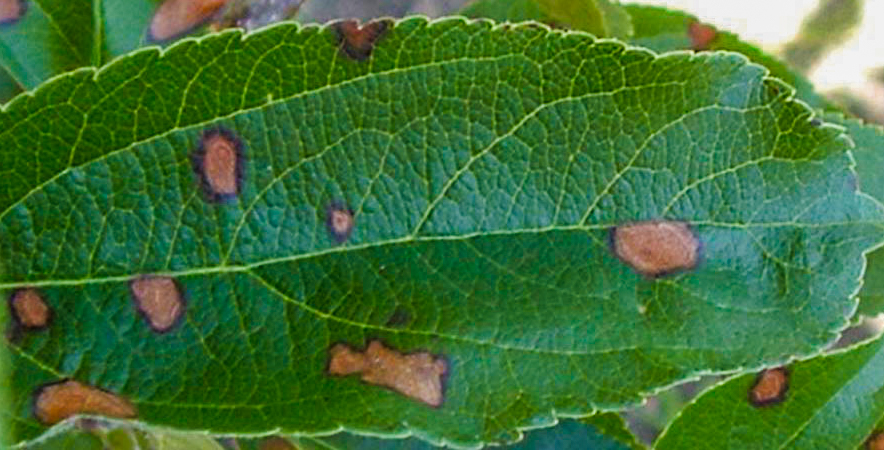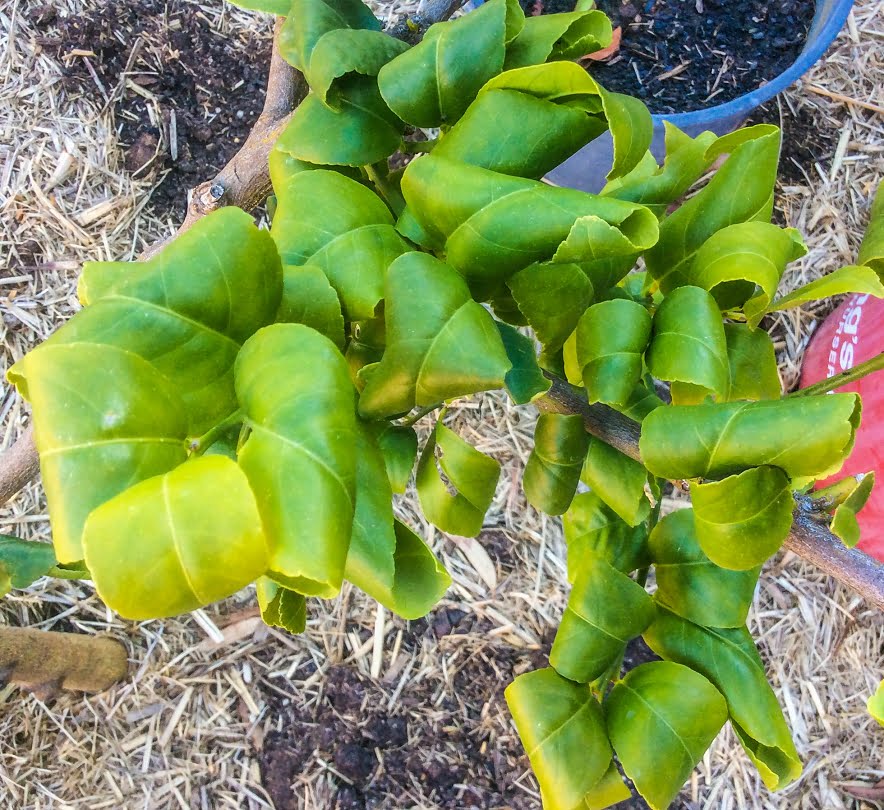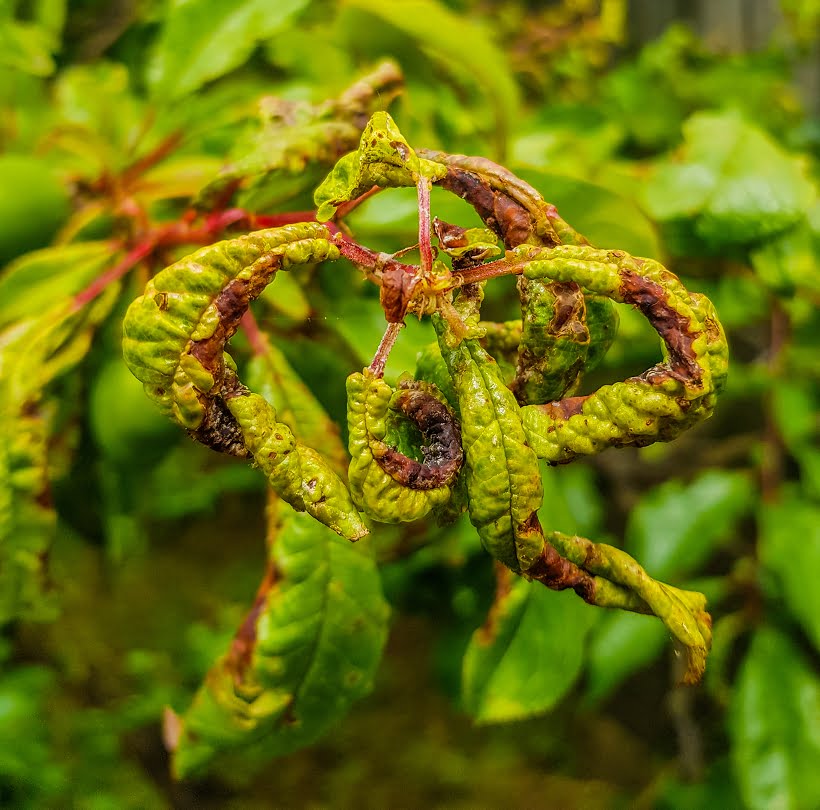Understanding and Treating Leaf Curl in Fruit Trees
Of all the problems that can occur with fruit tree leaves, curling leaves are one of the most common. Curly leaves on fruit trees are never a good sign! It’s one of the ways your tree is signalling that all is not well.
Curly leaves can be caused by many things, the main ones are (a) fungal disease, (b) insects, (c) poor nutrition, and (d) watering issues.
Leaf Curl in Peach and Nectarine Trees
If your peach or nectarine tree has curly leaves, chances are it’s caused by a very common fungal disease. Funnily enough, the disease is called “Leaf curl”.
There are hundreds (if not thousands) of peach and nectarine varieties available. We grow more than 20 varieties here on the farm. And guess what? All of them are vulnerable to Leaf curl disease!
Leaf curl is one of those diseases that seems to exist wherever there are peach and nectarine trees. The good news is that it’s preventable!
Whether or not you get the disease in any given season is not random. In fact, it depends on two main factors. The first is the weather, because a rainy season creates exactly the right conditions for the disease to thrive.
The second factor is whether or not you take the right precautions. We hear a lot of myths (like hanging particular weeds in peach trees can prevent leaf curl). Sadly, that’s not true, but luckily, there are some tried and true methods that do work.
Other Causes of Leaf Curl in Fruit Trees
Curly leaves on other fruit trees (not peaches or nectarines) are always caused by something other than Leaf Curl disease. Broadly speaking, there are 4 main reasons for curling leaves:
- Fungal disease,
- Insect damage,
- Nutritional problems, and
- Water issues.
Different types of fruit trees tend to get curly leaves for different reasons. In apple trees, the most common causes are insects.
If you’re in Australia, it might be caused by thrips, psyllids, or mealybugs. In the US, New Zealand (and pretty much everywhere else), a tiny insect called the apple leaf curling midge is more likely to be the culprit—we’re lucky we don’t have this one in Australia yet!
Curly leaves in citrus trees can also be caused by lots of different things. Insects are often to blame, and it’s always worth having a good look at your citrus leaves to see if you can spot the culprit.
A word of caution: just because you see an insect on your citrus tree doesn’t mean it’s the enemy! Many insects will happily live on your trees without causing any problems at all, so don’t be too hasty to get rid of them.
In fact, it’s easy to do more harm than good by indiscriminately banishing insects from your fruit trees. It makes more sense to do some detective work first!
Another common reason for curly leaves in citrus trees is either too much water, or not enough water!
It’s also common to see curled leaves in plum or cherry trees. In that case, a likely reason is aphids. Look out for bunches of tightly curled leaves and check inside the leaves for any sign of tiny black insects.
Just to confuse things, aphids are also found in peach and nectarine trees, and to further complicate things your tree is more likely to attract aphids if it already has a case of Curly leaf!
Why Leaf Curl Matters
Curly leaves aren’t just an aesthetic issue. They can seriously impact your tree’s health and fruit production.
When leaves curl, they often struggle to photosynthesize properly, meaning your tree has less energy to grow and produce fruit. In severe cases, leaf curl can weaken the tree over time, making it more susceptible to other diseases and pests.
Understanding the cause early is the best way to keep your fruit trees strong and productive.
Should You Remove Curled Leaves?
Many gardeners wonder whether to remove curled leaves from their trees. The answer depends on the cause, but is usually no.
If the curling is due to a fungal disease like peach leaf curl, there’s no good evidence to show that it’s worth removing and destroying affected leaves. However, it won’t do any harm and will probably make you feel better!
Unfortunately, removing infected leaves doesn’t influence the severity of the disease. However, it’s important to make sure any infected leaves that have fallen to the ground have disappeared before the following spring.
What about pests?
If pests are the cause for the symptom, removing leaves won’t help unless the insects are inside them. Even then, if the leaf is still functioning (i.e., photosynthesising), then it’s usually better for the leaves to stay on the tree.
An exception is when removing insects will help to get the pest problem under control, for example, an active aphid infestation. Removing bunches of active insects can help predator insects to clean up the population. A word of caution: try not to damage the structure of your tree when removing bunches of infested leaves.
The main strategy is to focus on controlling the pest population and keeping the tree healthy.
The Role of Soil Health in Preventing Leaf Curl
Healthy soil is the foundation of a strong, resilient fruit tree. Trees growing in poor, compacted, or nutrient-deficient soil are more likely to develop issues like leaf curl because they’re already stressed. A well-balanced soil with plenty of organic matter helps trees take up the nutrients they need to fight pests and diseases.
Regularly adding compost, mulch, and organic fertilizers can improve soil structure, retain moisture, and support beneficial microbes that help keep your trees in top condition.
When Not to Worry About Leaf Curl
Not all leaf curl is a major cause for concern. Sometimes, a few curled leaves here and there are just a sign of temporary stress, like a hot day or a small insect presence. So, how do you know when to take it seriously?
If your trees leaves are looking curled or wilted at the end of a hot day, be sure to check them again the following morning. If they’re once again perky and bright, there’s no need to worry, the tree is not under water stress. If they are still looking poorly in the morning, the tree is telling you it’s not getting enough water. If you’re experiencing drought or dry conditions, you’ll need to use your water wisely to make sure your trees stay productive.
If the curling is widespread, or accompanied by yellowing or dieback, it’s a sign that something more serious is going on. In these cases, acting quickly to identify the cause can prevent long-term damage and protect your fruit harvest.
Need more help? Check out more resources about apricot trees.
Free Resources
Still keen to learn more about apricot trees? Excellent! It’s worth putting in the time to get the hang of growing these fickle beauties, because the rewards are so big—delicious, sun-ripened, home-grown apricots!
🍃 Download Quick Leaf Problem Identification Guide
Grow Great Fruit Program
Are you still worried about curly leaves? Getting to the bottom of leaf problems can help to set you up for your best fruit-growing year yet.
In the Grow Great Fruit program, we help you tackle leaf problems and we give you skills to grow healthier trees and bigger harvests across your whole orchard.
Each week you get a checklist of seasonal jobs to prevent issues before they start. There are step-by-step videos and guides on pruning, pest and disease prevention, and every other fruit growing topic.
Need answers? The Members Forum is full of answered questions from other growers who’ve been in your shoes. And Premium members get personal answers to questions from us for quick, expert support.
Let’s get your fruit trees thriving—this season and beyond.







